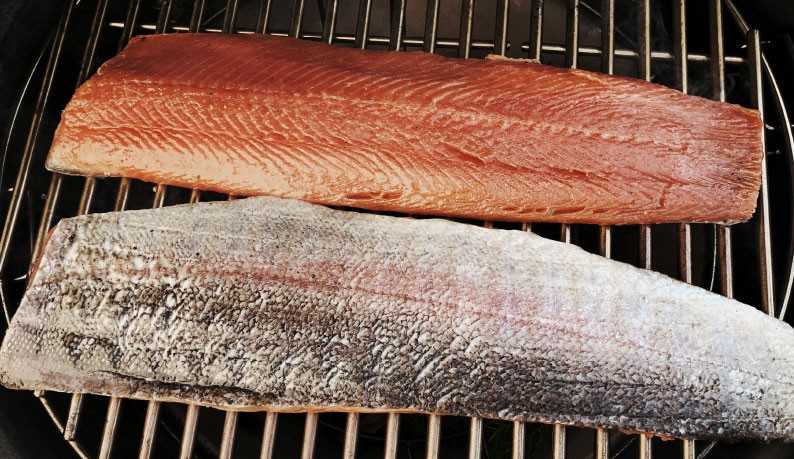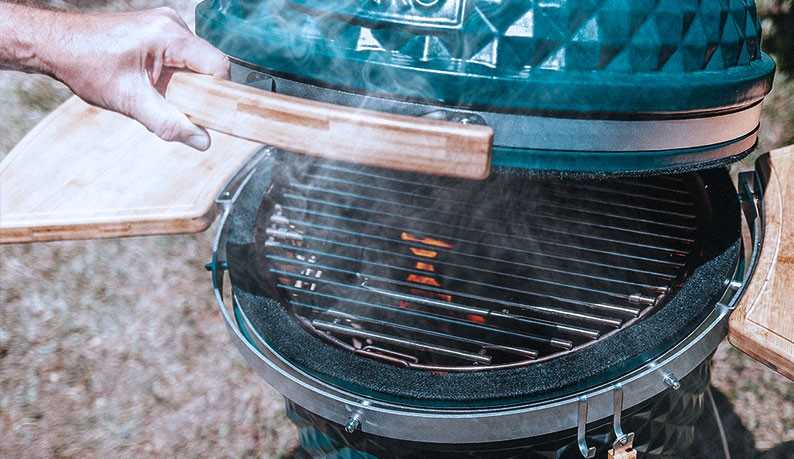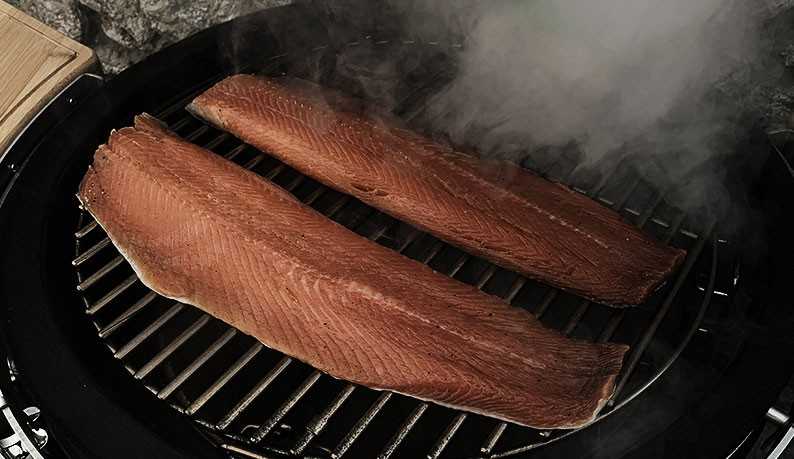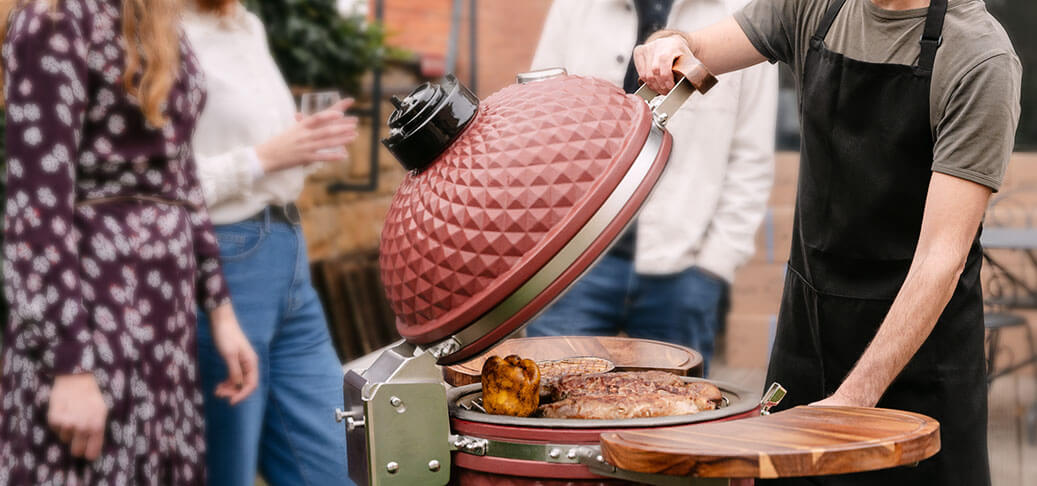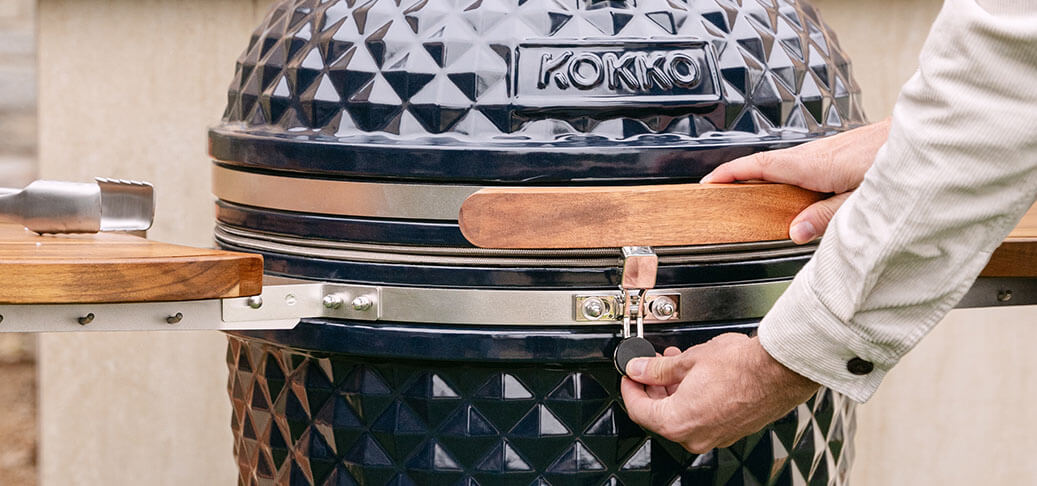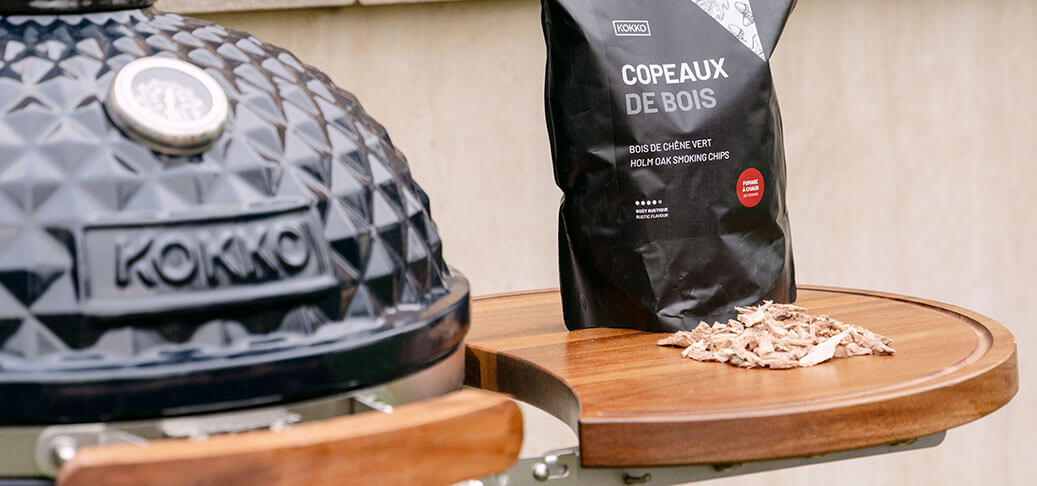
The homemade smoked salmon recipe offers an incomparable taste experience to the industrial versions found in supermarkets. Delicately flavored and with a melt-in-the-mouth texture, homemade smoked salmon quickly becomes a culinary pride and joy to share.
Indeed, preparing smoked salmon is not as complex as one might imagine. From the salting time and choice of salmon to the smoking of the salmon itself, every step is accessible to the amateur cook. This guide details the entire process: ingredient selection, thenecessary equipment (including the Kamado Kokko salmon smoker, renowned for its versatility and precision), and techniques for achieving perfectly balanced home-smoked salmon. What's more, Kokko smoking accessories optimize results, transforming a simple recipe into a culinary masterpiece. Whether you're a novice or an experienced smoker, this step-by-step guide will lead you to guaranteed success.
Table of contents [hide]
The essential equipment for smoking salmon
For a successful homemade smoked salmon recipe, the right equipment is essential. The right equipment turns a simple culinary endeavor into a gastronomic success. Here are the essential tools for mastering salmon smoking.
Smoking at Kamado Kokko
The Kamado Kokko is a revelation for smoking enthusiasts. This type of salmon smoker, inspired by ancestral Japanese techniques, is distinguished by its ceramic structure that maintains a constant temperature, a fundamental element for successful smoking. Unlike traditional smokers, the Kamado Kokko offers remarkable versatility.
Its innovative design enables precise temperature control between 70°C and 400°C, ideal for smoking salmon, which requires gentle, prolonged heat. What's more, its dual ventilation system ensures optimum circulation of smoke around the fish, guaranteeing even impregnation of aromas.
The Kamado Kokko's heat insulation capacity is also a major asset. In fact, this feature enables it to maintain a stable temperature for several hours while consuming less fuel. This is crucial when preparing smoked salmon, which often requires long smoking times.
Recommended kokko smoking accessories

To take full advantage of the Kamado Kokko's capabilities, certain specific accessories are essential:
-
Serpecold smoking coil - Ideal for cold-smoking salmon, this stainless steel coil diffuses a fine, constant smoke, for melting, delicately scented salmon. Optimizes airflow and facilitates cleaning in your Kokko.
-
Smoke-generating tube - Perfect for hot-smoking salmon, this tube produces even smoke and lets you add shavings without opening the lid, preserving temperature and aroma.
-
Special fish holders - These stainless steel holders hold salmon in an ideal position for even exposure to smoke.
The combination of these Kokko accessories turns what could be a complex process into a mastered experience, even for beginners in the art of salmon smoking.
Thermometer, grids, wood shavings
The thermometer is probably the most crucial tool after the smoker itself. A digital probe thermometer allows you to monitor the temperature without opening the Kamado, thus avoiding damaging temperature variations. For home-smoked salmon, maintaining a temperature between 65°C and 85°C is ideal.
When it comes to grates, stainless steel is the best choice, as it resists corrosion and high temperatures. Special grates for fish, with their non-stick surfaces, make handling salmon much easier without the risk of damaging it.
Wood chips play a decisive role in the final aromatic profile:

-
Beech: Offers a light, subtle smoke, perfect for salmon.
-
Maple: Gives off softly sweet notes
-
Cherry: Gives a delicate fruity touch
-
Apple: Gives a slightly sweet, fruity aroma
It is advisable to soak the chips for around 30 minutes before use, to prolong their combustion and obtain a denser smoke. However, this step is optional with the Kamado Kokko, whose optimized ventilation system already provides excellent combustion control.
The quality of the salmon salting time before smoking is just as important as that of the equipment used. However, even the best preparation process will not produce optimum results without the right tools. Investing in quality equipment like the Kamado Kokko and its specialized accessories is therefore the first step towards successful salmon smoking.
How to prepare salmon
Preparing the fish is the fundamental step before successful smoking. A perfect homemade smoked salmon recipe begins long before the smoker is lit, with the selection of the raw material. Every gesture counts and has a direct influence on the final quality of the product.
Choosing a quality salmon
The excellence of homemade smoked salmon depends above all on the quality of the raw fish. For optimal smoked salmon preparation, choose fresh rather than frozen salmon. Here are the essential criteria for recognizing a good salmon:
-
Firm, elastic flesh that springs back into shape when lightly pressed
-
uniform pink-orange colour with no brown or grayish areas
-
Fresh scent reminiscent of the ocean, with no ammonia notes
-
Bulging, shiny eyes if you buy a whole fish
-
Shiny, well-attached scales
Wild salmon is generally tastier and less fatty than its farmed counterpart. Nevertheless, some responsible farms produce excellent fish. To guarantee freshness, buy from a reputable fishmonger who can advise you on the origin of the product.
Fillets weighing between 1 and 1.5 kg are ideal for a first smoking experience. This size makes them easy to handle, especially on the Kamado Kokko's special grids, designed to optimize the circulation of smoke around the fish.
Stripping and cutting
Once the salmon has been selected, theboning stage is crucial. Bones can spoil the taste experience and must be carefully removed before the salmon is smoked.
For effective boning, place the skin fillet against the work surface. Gently run your fingers over the entire surface to locate the bones. Use a pair of boning pliers or tweezers reserved for this culinary purpose to extract each bone in the direction in which it was inserted. This careful method avoids tearing the flesh.
When it comes to cutting, you have two options:
Firstly, you can work with whole fillets, which are particularly well suited to Kokko smoking accessories that hold the fish in an ideal position throughout the smoking process.
Secondly, to facilitate smoking of large salmon, cut the fillet into regular portions of around 300 to 400 grams. This technique ensures even salt penetration during the salmon-salting time before smoking, as well asuniform exposure to the smoke.
For perfect slices after smoking, cut perpendicular to the fish fibers, using a sharp, slightly moistened knife.
Cleaning and shaping
Before salting, meticulous cleaning of the salmon is a crucial step. Rinse the fish thoroughly in cold water to remove any scales and impurities. Then gently pat dry with paper towels.
Shaping is designed to optimize the fish's exposure to smoke and facilitate its subsequent handling. Remove the thinner belly part (also called "ventrèche") which would cook too quickly in the salmon smoker. This part can be reserved for separate cooking or eaten as tartare.
If you're preparing a whole fillet, even out the thickness by trimming the edges slightly to obtain a rectangular shape. This ensures even penetration of salt and smoke.
Next, check that all black bits of skin (known as "melanin") have been removed, as they can impart bitterness to the final product. A careful look in good light will help you spot them.
To facilitate handling during smoking in your Kamado Kokko, you can arrange the fillets on greaseproof paper or use the special fish holders available in the Kokko smoking accessories. These supports hold the salmon in an optimal position, ensuring ideal circulation of smoke around the fish.
At this stage, your salmon is ready for the next step: salting, fundamental to the success of your homemade smoked salmon. This meticulous preparation guarantees a solid base for the entire smoking process.
Salting salmon: techniques and times
Salting is the decisive step that transforms a simple salmon fillet into the perfect base for smoking. This crucial phase of the homemade smoked salmon recipe directly influences the texture, preservation and, of course, the taste of the final product. Mastering salting techniques is therefore an essential skill for any smoked salmon enthusiast.
Salmon salting time before smoking
The ideal salting time depends mainly on thethickness of the fillet. For a successful home-smoked salmon, you need to respect precise times:

-
For a fine fillet (less than 2 cm): 12 to 16 hours of salting are sufficient.
-
For a medium-thick fillet (2-3 cm): 18 to 24 hours are required
-
For thick mesh (over 3 cm): 24 to 36 hours guarantee optimum penetration
Too little salting results in limited shelf life and an undeveloped taste. Conversely, excessive salting makes the salmon too dry and excessively salty. When using the Kamado Kokko, this time precision takes on its full meaning, as this salmon smoker perfectly reveals the subtleties of well-executed salting.
Temperature also plays a decisive role. Salting must take place in the refrigerator at between 2°C and 4°C to avoid bacterial growth. Some Kokko smoking accessories, such as special trays, make it easy to transfer salmon directly from the fridge to the smoker without excessive handling.
Dry vs. brine salting
There are two main methods for preparing smoked salmon: dry salting and salting in liquid brine. Each has its own specific advantages.
Dry-salting consists of coating the fillet directly with a mixture of salt and possibly sugar. This traditional technique allows for greater dehydration, ideal for smoking salmon in Kamado Kokko which, thanks to its precise temperature control, perfectly preserves the texture obtained. For dry salting, use around 65-80 g of salt for 1 kg of salmon. Apply the mixture evenly to all surfaces of the fish, then wrap in cling film before placing in the fridge.
Brine salting, on the other hand, immerses the salmon completely in a saltwater solution. This method ensures more even salt penetration and preserves the fish's natural moisture content. To prepare an effective brine, dilute 100 to 120 g of salt in 1 liter of cold water. Then immerse the salmon for the time appropriate to its thickness.
Nevertheless, whatever method you choose, it's essential to rinse the salmon thoroughly in cold water after salting to remove excess salt from the surface. This step, often overlooked, prevents the final product from becoming too salty when smoked in your Kamado Kokko.
Spices and herbs to add
Adding spices and herbs during the salting process allows you to personalise your homemade smoked salmon. These herbs delicately infuse the flesh during the salting process before smoking. Here are a few particularly successful combinations:
-
Nordic classic: crushed juniper berries, chopped fresh dill, lemon zest and white pepper
-
Intense aromatics: wild fennel, coriander, star anise and pink pepper
-
Sweet: brown sugar, orange zest, cardamom and vanilla
-
Asian fusion: grated ginger, lemongrass, combava and a hint of soy sauce
To integrate these aromas, add them directly to the salt mixture for dry salting or to the liquid brine. The ideal proportion is around 10% herbs and spices by weight of salt.
So, after perfectly controlled salting, your salmon will be ready for the drying stage, then for smoking in your Kamado Kokko. Kokko smoking accessories, such as the heat deflector, will then enable you to precisely control the circulation of smoke around the salted fish, guaranteeing optimal absorption of the woody aromas. This attention to detail right from the salting stage forms the basis of an exceptional homemade smoked salmon recipe.
Salmon drying: why it's essential
After salting, thedrying stage represents a crucial link in the chain of preparation of home-smoked salmon. Often overlooked by novices, this phase largely determines the final quality of the product. Drying allows the salmon to develop the characteristic shiny film called"pellicule", which then optimizes theadhesion of the smoke.
Fridge drying method
Refrigerator drying is the easiest and safest way to prepare your salmon for smoking. After rinsing and gently drying your salted fish, place it on a raised rack, skin side down. This position ensures optimum air circulation around the entire surface of the fillet.
Place in the bottom of the fridge, at a constant temperature of between 2°C and 4°C. An essential point: don't cover the salmon during this phase. Exposure to the cool, dry air of the refrigerator encourages the gradual evaporation of surface moisture.
For Kamado Kokko users, specific smoking accessories make this step much easier. In particular, special salmon grids hold the fish in an ideal position throughout the drying process, then transfer it directly to the smoker without excessive handling that could damage the precious film formed.
Ideal duration
Drying times vary according to the thickness of the mesh and the desired drying intensity. As a general rule, allow :

-
6 to 8 hours for a fine fillet (less than 2 cm)
-
12 to 18 hours for a medium-thick fillet (2-3 cm)
-
18 to 24 hours for a thick fillet (over 3 cm)
Salmon is ready when its surface becomes slightly shiny and tacky (sticky to the touch). This characteristic indicates the formation of a protective film, essential for smoking salmon.
There's also a simple test to check whether drying is sufficient: gently touch the surface of the fish with your finger. If your finger leaves a slight imprint, which quickly disappears, drying is optimal. On the other hand, if the flesh still feels damp, or if your finger digs in too easily, extend the drying time by a few hours.
Impact on final taste
Drying has a considerable influence on the organoleptic qualities of home-smoked salmon. Firstly, it concentrates flavors by reducing water content, intensifying the salmon's characteristic taste.
Secondly, the film formed during drying plays a decisive role in the absorption of smoke aromas. Insufficient drying will leave the surface too moist, preventing the aromatic particles from adhering properly. Excessive drying, on the other hand, risks dehydrating the fish too much, leaving it dry and fibrous after smoking.
Last but not least, perfect drying gives the salmon that distinctive semi-firm, semi-melting texture that is the hallmark of a good smoked salmon recipe. In the Kamado Kokko, where air circulation and temperature control are particularly precise, a properly cured salmon will develop an even amber color and a perfectly balanced texture.
Indeed, this step ideally prepares the fish to receive the wood aromas that your salmon smoker will then diffuse. Master smokers often consider that the quality of drying determines 50% of the final success of a salmon in the smoker.
Salmon smoking: success every time
The long-awaited moment has finally arrived: after preparation and drying, it's time to smoke the salmon itself. This final step transforms your meticulous preparation into a gastronomic delight. The smoking process requires precision and care, but the exceptional results of your home-smoked salmon will more than justify your efforts.
Smoking temperature and duration

Temperature control is crucial to the success of your smoked salmon recipe. There are two main techniques:
Cold smoking (20°C-30°C) preserves the salmon's silky texture and allows the flavors to penetrate deeply. This traditional method takes between 2 and 4 hours, depending on the thickness of the fillet and the desired aromatic intensity.
Hot smoking (70°C-80°C), on the other hand, partially cooks the fish and flavors it. Allow 45 minutes to 1h30 for optimal results. This technique develops more pronounced flavors and a slightly firmer texture.
Whichever method you choose, keep a close eye on the colour the salmon during smoking. A beautiful golden amber color generally indicates successful smoking. Also, avoid opening your salmon smoker frequently, aseach time you do, you lose temperature and smoke, which lengthens the process.
Which wood to use for a subtle taste
The choice of wood has a considerable influence on the final flavor profile of your home-smoked salmon. Certain types of wood go particularly well with this delicate fish:
-
Beech: the classic par excellence, offering smooth, balanced smoke
-
Maple: adds a much-appreciated hint of sweetness
-
Cherry: gives a fruity aroma and a lovely pinkish hue
-
Apple: develops a subtly fruity, sweet flavour
-
White oak: for more pronounced, traditional smoking
Generally speaking, medium-sized wood chips produce the smoothest smoke. Before use, some enthusiasts dampen them slightly to prolong combustion and soften the aromas released.
Conversely, absolutely avoid resinous woods (pine, fir, spruce), which contain toxic substances. Similarly, overly intense woods such as mesquite or walnut can easily overpower the natural delicacy of salmon.
Using Kamado Kokko for controlled smoking

The Kamado Kokko is the ideal ally for perfectly controlled salmon smoking. Its ceramic structure maintains a remarkably stable temperature, a fundamental element in obtaining exceptional smoked salmon.
To fully exploit its capabilities, start by preheating your Kamado Kokko to the desired temperature. Next, place the heat deflector (an essential Kokko smoking accessory) to ensure indirect heat. Place the wood shavings in the special charcoal basket, then position your salmon on the upper grill.
The Kamado Kokko's dual ventilation system allows precise control of smoke intensity. For delicate smoking, set the lower vents to around 1/4 opening and the upper vent to 1/3. These fine adjustments ensure optimum circulation of smoke around the fish.
So, thanks to the Kamado Kokko's excellent thermal insulation, you can maintainconstant low temperatures for several hours without excessive fuel consumption - a considerable advantage for cold smoking, which requires patience and regularity.
The lid-mounted thermometer, ideally complemented by a remote probe (available as a Kokko accessory), allows precise temperature monitoring without opening the smoker, preserving the controlled environment necessary for a perfect smoked salmon recipe.
After smoking, leave your home-smoked salmon to rest for a few hours before tasting. This final rest allows the aromas to stabilize and the texture to balance perfectly. Then slice thinly and enjoy the fruit of your patience and expertise.
Preservation and hygiene after smoking
Once the salmon has been smoked, its proper storage becomes just as crucial as its preparation. Indeed, even the most delicious home-smoked salmon would quickly lose its qualities without proper storage techniques. Mastering these methods not only extends the life of your culinary creation, but also preserves all its flavors.
Cool storage
Once completely cooled, the smoked salmon should be immediately transferred to the refrigerator. First wrap it in parchment paper or aluminum foil, then place it in an airtight container. This double protection prevents dehydration while isolating the powerful aromas that could impregnate other foods.
The ideal temperature is between 0°C and 4°C, a zone where the special preservation trays in Kokko's smoking accessories prove their worth. They are designed to maintain smoked salmon in optimal conditions without crushing its delicate texture.
Also, avoid storing your home-smoked salmon in the refrigerator door, where temperature variations are more frequent. Instead, use the bottom shelf, which is naturally cooler and more stable.
Optimum shelf life

The shelf life of home-smoked salmon depends mainly on its salt content and degree of dehydration. Generally speaking, salmon properly smoked in a Kamado Kokko will keep for 5 to 7 days in the refrigerator in its original packaging.
To extend this timeframe to 2-3 weeks, a tip is to slice thinly and then interleave each slice with parchment paper before placing them in an airtight container. This method limits oxidation and preserves the melting texture.
Freezing is also an excellent option for long-term preservation. Carefully vacuum-packed homemade smoked salmon can be kept in the freezer for up to 3 months without any noticeable deterioration in quality. However, thawing should be done slowly, ideally 24 hours in the refrigerator.
Equipment hygiene
After every salmon smoking session, the Kamado Kokko needs to be thoroughly cleaned. First, let the unit cool down completely before handling. Next, remove ashes and wood residues using the special shovel supplied with Kokko smoking accessories.
Grills should be cleaned in hot, soapy water immediately after use, while still warm. For stubborn residues, a special wire-bristle barbecue brush is effective without damaging the materials.
As for the inside of the Kamado, a simple brushing is generally sufficient - avoid detergents that could impregnate the ceramic and affect future smoking. The layer of creosote that forms naturally on the inside contributes to smoking performance and does not need to be systematically removed.
This attention to preservation and hygiene guarantees not only safe tasting but also the longevity of your future smoked salmon recipes.
Homemade smoked salmon recipes

After all the effort you've put into preparing your homemade smoked salmon, it's time to enjoy the fruits of your labor in simple yet elegant recipes. The incomparable quality of the salmon prepared in your Kamado Kokko transforms even the simplest dishes into memorable gastronomic experiences.
Toast and bread
Tartines are probably the purest way to enjoy your homemade smoked salmon. On a lightly toasted slice of rye bread, spread a thin layer of semi-salted butter or fromage frais. Then place a few thin slices of your smoked salmon, cut perpendicular to the fibers to preserve the delicate texture achieved by the Kamado Kokko's precise temperature control.
To enhance these tartines, add a few capers, thin slices of red onion, a drizzle of lemon juice and a touch of fresh dill. For a more sophisticated version, add slices of avocado and a few quail eggs. The subtle woody aromas impregnated during smoking blend perfectly with these light accompaniments.
Fresh salads
In summer, homemade smoked salmon makes a wonderful addition to refreshing salads. Mix tender mesclun leaves with wedges of citrus fruit (grapefruit or blood orange), a few slices of crunchy fennel and your precious slices of smoked salmon. A light vinaigrette of olive oil, lemon juice and a touch of honey completes the picture.
On the other hand, a warm new potato salad with smoked salmon, soft-boiled eggs and fresh herbs is a complete and balanced meal. The delicate aromas impregnated during smoking in your Kamado Kokko are fully revealed at room temperature, justifying the investment in quality smoking accessories.
Pasta with smoked salmon
For a comforting dinner, pasta with smoked salmon is a tasty option. Cook tagliatelle al dente, then add a light sauce of crème fraîche, lemon juice and dill. Add your smoked salmon in pieces at the last moment, without cooking it any further to preserve the delicate aromas obtained during smoking.
Kamado Kokko's precise temperature control during salmon smoking ensures an ideal texture that blends perfectly with the creamy sauce. A few zests of lemon and a touch of freshly ground black pepper complete this simple yet elegant dish, demonstrating that a well-executed homemade smoked salmon recipe can transform even everyday dishes into memorable gastronomic experiences.
Professional advice and mistakes to avoid
Mastery of detail makes all the difference between a decent smoked salmon and a true culinary masterpiece. Even with the best equipment like the Kamado Kokko, certain mistakes can compromise the final result. Here's expert advice on how to perfect your homemade smoked salmon recipe.
| Do not over-salt | For a perfect balance,limit the amount of salt to 60g per 1kg of salmon, and scrupulously respect the salmon salting time before smoking. The salt continues to penetrate the flesh even after rinsing. |
|
Avoid overcooking |
Overcooked salmon loses its melt-in-the-mouth texture and subtle aromas. So be sure to maintain the recommended temperature in your Kamado Kokko: 70-80°C maximum for hot smoking and 25-30°C for cold smoking. |
| Maintain your kamado regularly | After each use, clean the still-warm grates and remove the ashes once the appliance has cooled down. However, avoid aggressive detergents that could impregnate the Kamado Kokko's ceramic. |
Conclusion
And so ends our culinary journey through the art of home-smoked salmon. This ancestral technique, now accessible thanks to Kamado Kokko, transforms a simple salmon fillet into a gastronomic delight. Indeed, the quality of the fish chosen, combined with precise salting time and meticulous drying, forms the basis for assured success. But it's during smoking that the magic really happens.
The Kamado Kokko's exceptional thermal control plays a key role in this transformation. Its ceramic structure maintains a perfectly stable temperature, while its specific smoking accessories optimize the circulation of aromas around the fish. As a result, each bite reveals the subtlety of the selected wood essences.
There's no doubt that preparing homemade smoked salmon requires patience and care. However, the results far surpass the commercial versions. Every carefully executed step brings the amateur closer to master-smoker status, especially when the process is supported by the technical excellence of the Kamado Kokko and its dedicated accessories.
So let yourself be tempted by this culinary adventure. Mistakes are part of learning, but with shared advice and the right equipment, your smoked salmon will gain in perfection with each new attempt. In the end, it's not just a dish you create, but a personal savoir-faire that will impress family and friends for a long time to come.






